We’re down to the last part of this Blogging for Tourism Series. Our goal is to help tourism operators and businesses move forward and scale through blogging and content creation. For Part 5, let’s talk about travel website SEO in this post. You can also listen to the audio from the original podcast in the link above.
SEO is a broad topic; one that can be complicated and overwhelming, especially to novice content creators. Whether you’re a business that offers activity, attraction, hotel, tour, or transport, knowing some travel website SEO basics can help improve the quality of your content and website. Some SEO tools also help increase your website’s visibility.
Ready to create good SEO-friendly blog content? Read on. Or if you missed part 4 you can find it here.
Building Website Credibility
“Credibility is essential to show that your website is a trusted source.”
Understand how Google “Works” to recognize credible websites.
Every content creator wants their website to be a credible source of information. One crucial way to achieve that is to offer good quality content. With blogging, good content and SEO should always be balanced. Good content is actually an important aspect of SEO; without it, Google won’t be able to index your pages properly. This means your blog article won’t show in Search Results.
“Content is king in blogging, and good quality content is what’s going to make you win the SEO war.”
I can’t emphasize this point enough. In a world full of blogging tour websites, good quality content wins the war. Google changes its algorithm now and then. These algorithm changes aim to provide the best searchable content for Google users.
Google’s EATR Guidelines
One factor that Google uses to evaluate the quality of a web page is called the E-A-T-R guidelines. This stands for Expertise, Authoritativeness, Trustworthiness, and Relevance. These guidelines can help you write content that is trustworthy from the reader’s perspective.
Tip: As you’ve done with your tourism business, you need to build your reputation on your blog as well. Consider the EATR guidelines every time you create content to establish credibility and trust on your site.
When core updates happen, many content creators are often caught by surprise with the changes affecting SEO website performance. Important Tip: as long as you provide quality content that considers the EATR guidelines, no matter how many changes and updates Google will implement, your travel industry blogs will stay relevant.
How exactly do you build credibility on your website? (other than great content)
Set An Author Bar
An author bar tells the reader who you are, what you do, and your relevance in writing certain topics. It shows your audience why you are credible to write about a particular topic and why they should trust you for the information you share.
For example, if you’re a hotel owner in the Bahamas, you have the credibility to write about ‘The Best Tours in the Bahamas’ If your website accepts guest posts, the author bar indicates who the author is and their relevance to the topic.
Create an About Us Page
An About Us page is the perfect place to tell readers who you are as a business, what you do, and the people behind the company. An About Us page matters to SEO, because it is one of the options identified in the Google EAT guidelines to establish trust in your niche.
Getting Started: Travel Website SEO- On page for your blog
Now that we’ve established the importance of content to SEO and how to build your website’s credibility, let’s look at how you can create quality and highly relevant content.
What makes content good and relevant anyway?
Keyword Research 101
1. Do in-depth keyword research.
How do you tell Google your content is about a certain topic? It’s through keywords. This is why you don’t skip keyword planning. It’s the backbone of good on-page SEO practices and consumers finding your business. Do in-depth keyword research and put those keywords in your article.
You have control over telling what your content is about because you know it better than anyone. You have control over choosing what keywords to include in your blog. However, you don’t have control over ranking for the words that matter to how your topic is searched.
Interestingly, you can rank for words that you don’t deliberately try to rank for. For example, you have an article about walking tours in New York City. You may rank for a keyword with ‘art’ in it that may not be related to your business. However, you want to control what words you rank for because you want to rank for the words consumers are searching for.
2. Pick many words to rank for within every blog post, not just one.
Maybe you’ve already heard it: pick just one word or phrase to rank for. Let’s break this assumption now. This is completely not true, especially with blogging. Aside from the main keyword, you can rank for hundreds of words more.
3. Check the performance of other websites ranking for a keyword.
Choosing a high-volume, low-competition keyword may be a good strategy, but it doesn’t mean your page will rank for it. Often, big websites with high domain authority and page links rank for those keywords. Remember, domain authority and backlinks matter. They show the quality and competitive strength of your site against other websites.
Face it, you won’t be able to compete on high volume and high ranking search terms against huge sites like TripAdvisor, Facebook, and Viator.
A better strategy is to use long-tail keywords with lower competition and search views. Instead of ‘walking tours in New York City’, why not try ‘food walking tours in New York City’? It is still relevant and provides a better opportunity for your business.
4. Make it your goal to rank on page 1 of SERP.
We all have different goals, but one thing is certain: we want our website to be visible to people. Therefore, ranking on page 1 of the Search Engine Results Page (SERP) matters and should be one of our objectives.
You may have the best content out there, but if it doesn’t show on the first page when people search a related keyword, it’s useless. Let’s admit it, we rarely check the 2nd, 3rd, or 4th page of Google SERP. Do you?
I recommend ranking for many smaller keywords with low average views, ranging from 75 to 300 monthly searches. These views can add up and will create good visibility for your blog posts over time.
5. Take advantage of keyword search tools
The internet is full of many good keyword search tools. If you’re a small-mid sized operator that blogs only monthly, I recommend using simple, affordable tools like Keysearch. This is a robust tool and great value for money. More extensive tools like AHREFS and SEMRush are excellent tools, but they are costly for average blogging activity.
6. SEO TOOLS Yoast and Rank Math Aren’t What You Think
Are Yoast and Rank Math still useful for tourism website SEO? Yes! These tools are on-page SEO optimization tools. They help you structure your blog articles so that they are adequately searched on search engines like Google.
Important Note: Yoast and Rank Math are not keyword tools. They neither help with choosing keywords nor tell if your keywords are the best for your website.
Rank Math is good for websites with a page speed issue like mine, as it doesn’t impact site speed. I personally like its approach to Schema Markup, which is a code that allows search engines to better represent your content in the search results.
When using tools like Yoast, be mindful of overusing a specific word in keyword tools. Sometimes, Yoast may recommend using a keyword several times – which is over-saturating that word, and it doesn’t come across as natural language. Essentially, it’s keywords stuffing—which is a no-no, which Google detects and may penalize you for.
Tip: Check your keyword list and use similar or related terms more throughout your post, this way you can also potentially rank for related keywords too.
Internal and External Links
Another factor that affects travel website SEO is links.
Internal Links
Internal links are links that go from one page of your website to another page. Internal linking is used to guide people to other content on your website. You’re building a system—your website, and you’re guiding the readers through a whole set of blogs. Internal linking also helps with on-site SEO, because it connects major pieces of related information. It’s like telling Google that a particular blog is related to another major topic on your site.
Tip: Put at least 2 to 3 internal links onto every blog post.
External Links
External links are links from a page of your website to a page of another website. Many times, content creators are reluctant to add external links to their posts. From an SEO standpoint, however, it can be helpful to link to external sources.
If you link to a website with higher domain authority, it shows that your blog post has a credible source. External links also open a way to backlinking possibilities.
Tip: Add at least 2 external links. You can share your blog post on social media, indicating that you included a good resource.
Anchor Text
Anchor text is the text or copy a specific link is anchored in. Good anchor text helps readers find the information they are looking for. For example, ‘click here’ is often used as an anchor text to direct readers to another page. This specific anchor text is not the best strategy for SEO.
Tip: For the anchor text, use text related to your topic. You can also use a secondary keyword to indicate that the information is helpful to the actual article.
More Good SEO Practices
Here are a few more useful tips to maximize your visibility on page:
- Include your main keyword in the title, URL, and meta description of the blog post.
- Good picture management is important. Name your pictures, because it helps Google to properly index your photo, thus improving your chance of visibility on Google Images. Fill out the Alt text to describe the photo; you can use a secondary keyword for this.
- Mind your picture sizes. Pictures that are too big or heavy can impact website speed and tourism website SEO. The rule of thumb is each picture should be around 100kB in size.
“Picture management is one of the best things you can do for on-page SEO.”
Here’s some extra help – FREE SEO Checklist
As a tourism business, it can be overwhelming to wrap your head around the many factors affecting SEO. Start by building your website as a credible source and providing good quality content to readers. It helps to use relevant keywords, include internal and external links, consider your anchor texts, make pictures more SEO-friendly, and utilize website tools. Making good SEO-friendly content should be a priority for tour operators with travel industry blogs.
For additional help, and a remember of all these steps, use this SEO Checklist to manage all the steps.
Download this detailed SEO checklist to get you started on-page SEO.
Unsure how to start with travel industry blogs? Catch up with the rest of this Blogging for Tourism Series Part 1-5.








